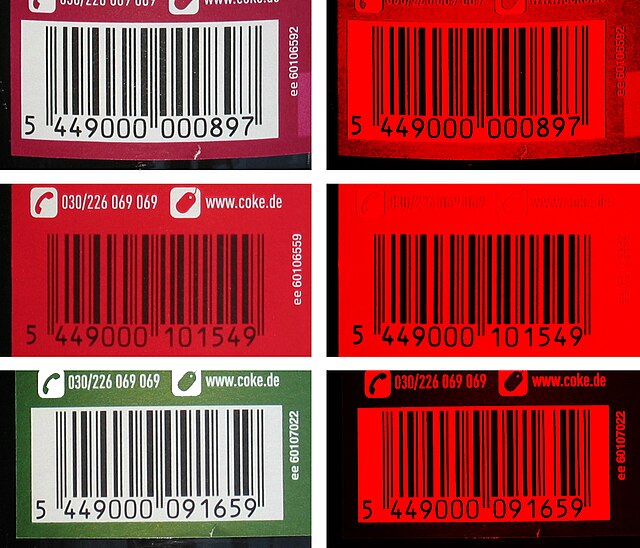A barcode or bar code is a method of representing data in a visual, machine-readable form. Initially, barcodes represented data by varying the widths, spacings and sizes of parallel lines. These barcodes, now commonly referred to as linear or one-dimensional (1D), can be scanned by special optical scanners, called barcode readers, of which there are several types.
Barcoded rolling stock in the UK, 1962
Snack vendor on the Shinkansen train scans a barcode.
Barcoded parcel
GTIN barcodes on Coca-Cola bottles. The images at right show how the laser of barcode readers "see" the images behind a red filter.
An image scanner—often abbreviated to just scanner—is a device that optically scans images, printed text, handwriting or an object and converts it to a digital image. Commonly used in offices are variations of the desktop flatbed scanner where the document is placed on a glass window for scanning. Hand-held scanners, where the device is moved by hand, have evolved from text scanning "wands" to 3D scanners used for industrial design, reverse engineering, test and measurement, orthotics, gaming and other applications. Mechanically driven scanners that move the document are typically used for large-format documents, where a flatbed design would be impractical.
A flatbed scanner. Documents or images are placed face-down beneath the cover (shown closed here).
Belinograph BEP2V wirephoto machine by Edouard Bélin, 1930
The first image scanner developed for use with a computer was a drum scanner. It was built in 1957 at the US National Bureau of Standards by a team led by Russell A. Kirsch. The first image ever scanned on this machine was a 5 cm square photograph of Kirsch's then-three-month-old son, Walden. The black and white image had a resolution of 176 pixels on a side.
Scanner unit with CIS. A: assembled, B: disassembled; 1: housing, 2: light conductor, 3: lenses, 4: chip with two RGB-LEDs, 5: CIS








